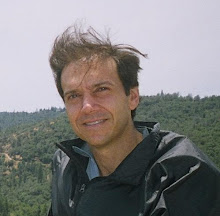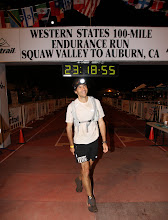After running “barefoot” a couple times a week during a few weeks, I decided that the protection offered to my soles by my “Vibram-five fingers” was not necessary and thus embarked on a totally barefoot run on pavement. Barefoot running is touted as an excellent way to strengthen the feet, particularly the arch, and Vibram makes a sort of foot-glove that protects the soles without reducing the barefoot experience. I had shed my Vibrams on the theory that I would use barefoot running to also toughen my feet and make them more resistant to blisters, but instead I ended up with a blister the size of a quarter on each of my heels -- five days before I was scheduled to pace a runner at Western States 2009. My wife’s facial expression said it all, “are you really that stupid?”
Not one to pass on the opportunity to learn something about running from the experience, I did extensive research on how to fix these blisters in time for the Western States pacing.
Dan Brendan, a friend and much accomplished ultra-marathoner (fifteen 100 mile races in 2008 alone) recommended cutting the outer layer of skin completely and applying NewSkin directly to the raw surface of the blister. “This will create a new artificial layer of skin but be prepared for it to hurt,” he said.
Gillian Robinson, an expert on the subject and co-owner of the running store Zombie Runner recommended cutting a small hole to allow the blister to drain completely and then to simply tape it with Elastikon. She suggested applying “tincture of benzoine” around the non-blistered surface to create a sticky surface to enhance the adhesiveness of the Elastikon tape to the skin. I had used this technique during my 2007 Western States run but never on such large blisters.
A U.S. Army training manual suggested draining the blister and then injecting tincture of benzoine directly into the blister and immediately pressing the outer layer of the skin to the blister so as to glue the surfaces together. Due to the extreme pain that this would cause for 15-20 seconds (think alcohol applied directly to raw surface and multiply the intensity by ten), a friend told me that I would want to bite on something while doing it. A somewhat less painful alternative involved injecting crazy glue into the blister. While I seriously considered the “military alternative”, I rejected it thinking that it would only provide a temporary solution and perhaps create a bigger problem down the road.
I then read an article by John Vonhof, author of Fixing Your Feet, suggesting a safer overnight alternative using zinc oxide. He recommended draining the blister and injecting zinc-oxide into the cavity. Zinc-oxide is the same ingredient used on babies to keep the wetness of a diaper from chaffing their delicate skin. The idea here is to dry out the blister overnight and then tape it in the morning in order to continue running. Eventually the body creates its own new skin over the blister.
Before I tell you about the blister-repair technique that I ultimately selected, let me tell you about yet another mess I created while draining the blister on the day of the barefoot run. The needle I used must have not been sterile, and I ended up introducing some bacteria into one of the blisters. This created an infection resulting in pain around the blister and red streaks emanating from the blister, surrounding the arch, and going towards the leg. I ended up taking care of this a few days later by visiting the Emergency Room while at Squaw Valley (where Western States 100 starts) and getting an aggressive course of antibiotics.
The night before the race, I cut two holes in each of the blisters to drain them completely. I made sure the holes were large enough to prevent themselves from sealing again and fluid from accumulating. I jammed a zinc-oxide paste into the holes, pushing it with a Q-tip and then spreading it inside by gently massaging it from the outside. I was pleasantly surprised to find the blisters fairly dry by the next morning. I applied some more zinc-oxide in the morning but waited to tape them until a couple of hours before I was to start pacing my runner. I then taped one foot with Elastikon and one with duct tape, to see which would hold better. In both cases, I cut a small "Engo Blister Prevention Patch" a little larger than the blister and placed the smooth surface towards the blister and the sticky surface against the tape. The idea here is to not let the tape adhere to the blister itself and for the blister to have a smooth surface against it at all times. I used tincture of benzoine to create a sticky area all around the taping surface (except on the blister itself), and I cut and applied a piece of Elastikon about three times the size of the blister on one foot and a similar piece of duct tape on the other. I also applied some baby powder over the Elastikon to create a smoother surface between the tape and the sock and thus prevent the edges of the tape from rolling from the friction.
The net result is that I was able to pace my runner for the 22 miles from Rucky Chucky to the finish line without much discomfort and was able continue running for another 13 miles thereafter, for a nice 35 mile run.
The Elastikon held better than the duct tape, but neither failed. While it may sound sadistic, I am glad to have had the opportunity to treat blisters this large. It gives me the confidence going into 2010 Western States that I have my blister-repair technique under control.
skip to main |
skip to sidebar


Read This First
Western States 2010 was only my second 100 mile race. My first 100 miler was also Western States in 2007, and I completed that one in 27 hours. If I can do WS in sub-24, so can you. I am a runner with average running talent but with above average discipline, preparation, focus, and determination. I hope the information in this blog helps you accomplish your Western States race goal. I'll be at the Rucky Chucky (Near Side) Aid Station helping you get to Auburn. Say Hello.
Training Races Completed
- 5/29 & 31/10 Western States Memorial Weekend Runs ( First Day: Started at N44 - due to snow - ran to Dustry Corners, on to Foresthill and continued to Rucky Chucky: total 45 miles; Second Day: Off; Third Day: 2 miles North of Greengate to Finish - 22 miles)
- 5/1/10 Miwok 100K, Marin Headlands, CA
- 4/17/10 Leona Divide 50M, Lake Hughes, CA
- 4/10/10 American River 50M, Sacramento, CA
- 3/27/10 Lake Sonoma 50M, Geyserville, CA
- 3/20/10 Rucky Chucky 50K, Foresthill, CA
- 3/13/10 Way Too Cool - 50K, Cool, CA
- 2/27/10 Sequoia Trail Run - 50K, Oakland, CA
- 2/13/10 Cool Trail Runs - 34M, Cool, CA
- 11/21/09 JFK 50M - Hagerstown, MD
- 11/07/09 Mount Masochist 50M++, Lynchburg, VA
- 11/01/09 NYC Marathon, NY
- 10/17/09 Mountain Madness 50K - Ringwood, NJ
- 10/10/09 Firetrails 50M - Castro Valley, CA
- 9/27/09 Vermont 50K - Ascutney, VT
- 9/21/09 North Face 50M - Washington DC
- 8/30/09 Green Lakes 50K - Fayetteville, NY
- 8/1/09 Catoctin 50K - Frederik, MD
- 7/18/09 Vermont 100 - Paced Dan Brenden for last 30 miles
- 6/27/09 Western States 100 - Paced David Pearon for last 22 miles & added 13 miles more on WS course
Avg Training/ Wk (non-rest week)
- May 2010 - 2.5 to 3 hrs 4-5x wk + 6-9 hours weekend
- April 2010 - 2 hrs 4 x wk + races on weekend
- March 2010 - 2 hrs 4 x wk + 8 hrs weekend
- Feb 2010 - 2 hrs 3 x wk + 7-7 1/2 hrs weekend
- Jan 2010 - 1.5 hrs 4 x wk + 6 hrs weekend
- Sept-Nov 2009 - 2 hrs 4 x wk + 7-9 hrs weekend
- August 2009 - 2 hrs 4 x wk + 6-7 hrs weekend
- July 2009 - 2 hrs 4 x wk + 5-6 hrs weekend
- June 2009 - 1.5 hrs 4 x wk + 4 hrs weekend
LINKS
- Crew Instructions Part 1 of 3
- Crew Instructions Part 2 of 3
- Crew Instructions Part 3 of 3
- All posts
- Crew Instructions Day Pictures
- Pictures while training at WS
- 1st Place (Geoff Roes) Blog Posting
- 2nd Place (Tony Krupicka) Blog Posting
- 4th Place (Nick Clark) Blog Posting
- Bryon Powell's irunfar.com
- My First 100 Miler (2007 Western States)
- 2007 WS in Pictures
- My First 50 Miler (2005 JFK)
- About Me
- Contact Me
Blog Archive

